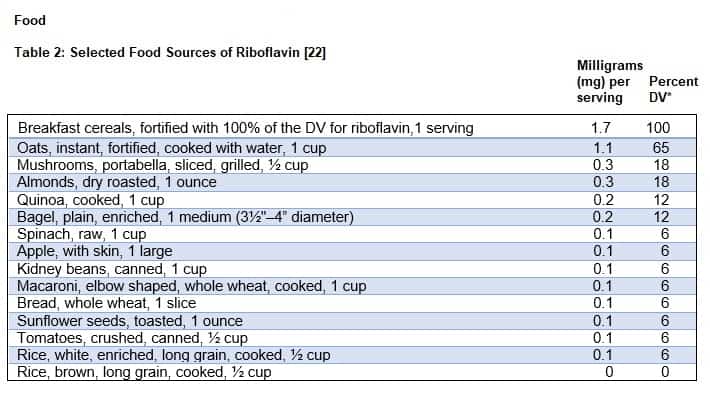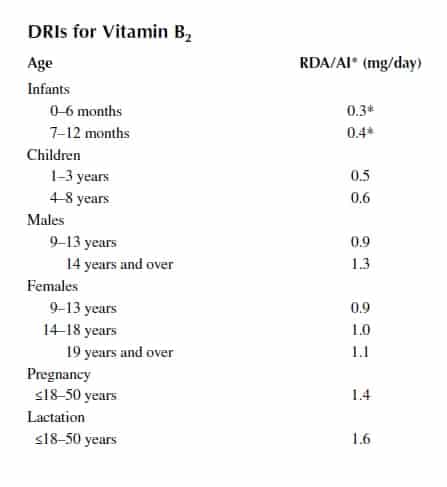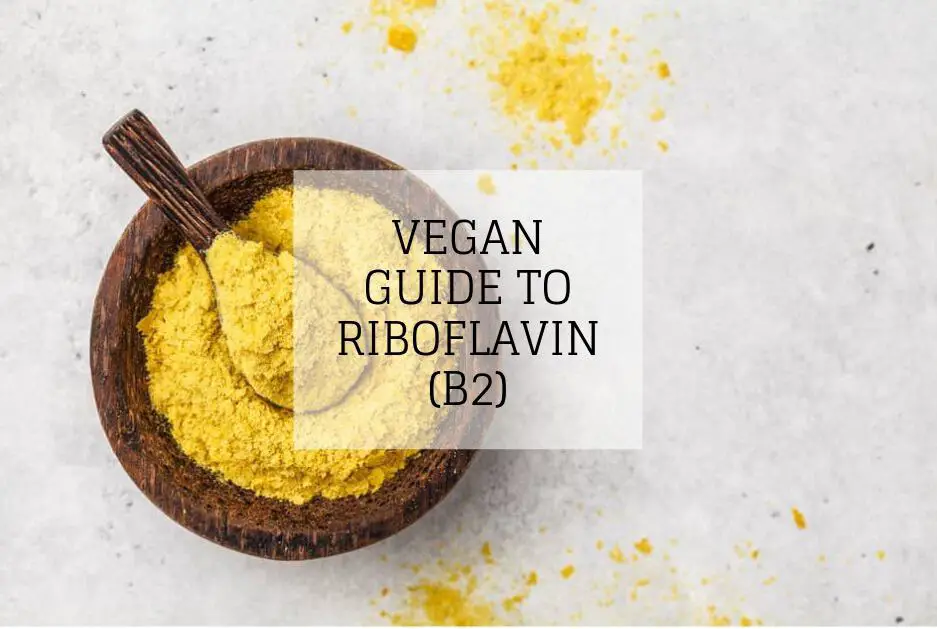It’s time to cover some basic information about riboflavin or vitamin B2 as relates to plant-based eating.
First, I’ll answer some common questions for those of you who are in a rush:
- Is riboflavin (B2) vegan? Yes, unlike vitamin D (check out the article here) there are plenty of plant sources for B2. As for supplements, riboflavin can be derived from animals but tends to be produced via microbial fermentation.23 So, it’s typically considered vegan.
- What are some vegan riboflavin sources? Common plant-based sources of riboflavin include mushrooms, legumes, fortified grains, and nutritional yeast.1 (See the chart below for more examples)
- Are vegans at risk for riboflavin deficiency? Only if you’re a vegan athlete according to the NIH and health organizations.1-3
What we’ll do here is take a closer look at riboflavin sources as well as some other basic info.
Overview and Functions
Riboflavin is one of the water-soluble vitamins. While thiamin was being recognized as causing beriberi, riboflavin (it’s B vitamin cousin) was being neglected. Scientists eventually isolated and described this flavoprotein as having vitamin properties.4
It’s a brightly colored crystalline substance that is red-orange in color when solid, but changes to a greenish yellow in solution accounting for that nuclear green-yellow color your pee takes on when you supplement with B complex.
Riboflavin is needed as a coenzyme in a number of oxidative enzyme systems. This is because flavins act as oxidizing agents due to their ability to accept a pair of hydrogen atoms.5
It carries out these functions as part of flavoproteins—a class of proteins containing a flavin group (go figure). Namely, FMN (flavin mononucleotide) and FAD (flavin adenine dinucleotide).6
The form of riboflavin found in food varies:6
- FMN and FAD are found in most foods.
- Then we have the free or protein-bound forms—specifically, in enriched cereals and bread, as well as eggs and milk.
- Finally, there’s the phosphorus-bound riboflavin and amino acid–bound FAD forms found in other foods.
Providing Energy from Macronutrients
Both FAD and FMN are involved in glycolysis and the electron transport chain. Thus, adequate riboflavin intake is crucial for extracting energy from carbohydrate, protein, and fat.
The molecule pyruvate gets oxidized in a process that connects glycolysis and the Krebs cycle. You may remember glycolysis from biology. It’s the process by which glucose (a molecule with 6 carbons) gets split into 2 pyruvates (with 3 carbons each).
It involves FAD and FMN as intermediate electron carriers with NADH as the final reduced product.5
FAD and FMN are involved at various points along the electron transport chain.
Micronutrient Metabolism
Riboflavin is in one way or another involved in the synthesis of other vitamins and in converting numerous vitamins into their active forms.
- Niacin synthesis from tryptophan (FAD)
- Folate synthesis (FAD as FADH2)
- Vitamin B6 (FMN)
- Vitamin K activation
FAD is also involved in choline catabolism.
DNA Synthesis
Deoxyribonucleotides (dADP,
Other Select Functions
- Neurotransmitter metabolism (FAD). Certain neurotransmitters (such as dopamine) and other amines (histamine and tyramine) require FAD for metabolism.7
- Glutathione metabolism. GSSG (the oxidized form) requires reduction to GSH which necessitates FAD.7
Sources
Unfortunately, milk is the best source of riboflavin found in the North American diet. Most other good sources happen to be animal products as well. For example, it’s found in high amounts in red meat, liver, poultry, and fish. But, there are some good plant sources.
Legumes
Riboflavin is found in decent quantities in legumes. For example, pinto beans provide around 0.05 mg per ½ cup serving.8
Fortified Grains
One cup of a generic wheat bran cereal with raisins provides around 0.9 mg riboflavin or about 56% of the Daily Value of 1.7 mg.9
While whole grains are healthier, refined grains are typically enriched with riboflavin and can help one meet their daily needs. They’re fortified because the bran and germ layers are removed during the milling process which results in the loss of about two-thirds of its riboflavin.
Fruits and Vegetables
Good vegetable sources include:
- Asparagus—1 cup provides 0.2 mg (14% DV).10
- Broccoli—1 stalk provides 0.3 mg (20% DV).11
- Leafy green vegetables. Spinach provides 0.05 mg of riboflavin per ½ cup serving.12
Other Great Sources
- Yeast—a mear ½ oz of nutritional yeast provides 9.7 mg which amounts to 570% DV!13
- Mushrooms—1 cup portabello mushroom provides 0.4 mg (24% DV).14
- Mushrooms are also a rare plant-based source of vitamin D
Select Riboflavin Sources

The DV in the above chart by which the values were derived is 1.7 mg for adults and kids age 4 and older.21 This value is actually changing to 1.3 mg per the updated Nutrition and Supplement Facts labels.20
The updated values won’t be mandatory on dietary supplements and food products until January 2020 but can be used now.21 Riboflavin isn’t a nutrient that the FDA requires to be listed on food labels unless a food product has been fortified with it. A food is considered a high source of a nutrient when it provides at least 20% of the DV, but foods that provide less than 20% still contribute to a healthy diet.
The U.S. Department of Agriculture’s (USDA’s) National Nutrient Database for Standard Reference external link disclaimer website makes available the nutrient content of many foods, providing a comprehensive list of foods that contain riboflavin.22
Recommended Daily Allowance (Needs)
Riboflavin recommendations (RDA) were derived from:
- The amount of vitamin B2 it takes to maintain normal activity of the riboflavin-dependent enzymes present in our red blood cells
- The normal excretion of riboflavin in the urine.
The RDA for adults is 1.3 mg/day and 1.1 mg/day for men and women, respectively.1Needs go up a bit for pregnancy and lactation increasing to 1.4 mg/day and 1.6 mg/day, respectively.1,15The additional B2 is needed to compensate for the riboflavin secreted in milk.

Source: Micronutrients in Health and Disease. Kedar Prasad – Crc – 2011
Deficiency Symptoms
As covered above, riboflavin is needed for DNA synthesis. So, when it’s deficient, injuries tend to heal poorly as new cells can’t grow to replace the damaged ones.
Ariboflavinosis
A hallmark of riboflavin deficiency are symptoms such as inflammation of the mouth, lips, tongue, and eyes—cracking at the corners of the mouth are common.16
This is because tissues that grow the most rapidly, (skin and the linings of the mouth, tongue, and eyes) are the first to be affected by a deficiency due to the role riboflavin plays in DNA synthesis.
Anyway, this condition is known as ariboflavinosis. Symptoms can become apparent after about 2 months on a riboflavin-poor diet.
Skin manifestations include:17
- Cheilosis: fissures or painful lesions on the outside of the lips
- Angular stomatitis: fissures/lesions at the corners of the mouth
- Glossitis: inflammation of the tongue.
- Hyperemia: red or bloody mouth.
- Edema: swollen mouth/oral cavity.
- Seborrheic dermatitis: an inflammatory skin condition. It’s associated with the secretion of a wax-like substance found around the nose or nasolabial folds.
Other manifestations:
- Peripheral nerve dysfunction (neuropathy).
- Anemia
- Mental confusion.
Keep in mind that this is not an actual disease, but more of a set of clinical symptoms.
Other Vitamin Deficiencies
Deficiencies of other vitamins as a result of riboflavin deficiency can happen for two reasons:
- The condition rarely occurs alone, as it usually surfaces in the presence of other B vitamin deficiency symptoms due to the overlapping food sources shared by B vitamins.
- Other vitamin deficiencies can occur because as we covered above, riboflavin is needed in the conversion of other vitamins to their active forms.
The Vegan Diet and Riboflavin Deficiency
Most dense sources of riboflavin are of animal origin. And, indeed vegans often report lower riboflavin intakes than omnivores or lacto-ovo-vegetarians. Interestingly, however, their intakes are still adequate for the most part.18
Even though many studies and surveys have shown vegans to have adequate intakes of riboflavin, it seems some portion of vegans likely end up deficient in this vitamin. There was a time when many vegans were presenting on Youtube with angular cheilitis—the condition of having sores at the corners of the mouth.
It’s no surprise given that many great sources of the vitamin tend to be animal sources. Milk is generally considered the most important source of B2 in the standard North American diet.
But, there’s no reason any of us should develop a deficiency if we pay attention to getting adequate amounts of the foods listed above. Namely, fortified and enriched whole grains.
A Note to Vegan Athletes
According to NIH and other health organizations, vegetarian athletes are at risk of riboflavin deficiency due to exercise producing stress in metabolic pathways that use riboflavin coupled with the exclusion of animal products like milk that typically play a large role in folks meeting riboflavin needs.1-3
Best Practices to Avoid Nutrient Loss/Deficiency
The vitamin is pretty resistant to heat, acid, and oxidation.6 But, if supplementing with B2, store in a cool dry place as riboflavin can be destroyed by exposure to sunlight (tidbit: this is the main reason milk tends not to be sold in glass bottles).6
Plant-based diets are high-residue. One of the reasons why they’re so great for weight loss is that a lot of the plant matter passes through the GI tract in tact. While this is great for cutting down on calories, unfortunately, many nutrients get lost in the process. Any nutrients that get smuggled in plant matter all the way to excretion do nothing to help you avoid deficiencies.
There are two ways to avoid this. One is to use a blender. Some blenders are so powerful, the cells in even the toughest plant material spill all their nutrients into your cup within a minute or two on high speed.
Another is to cook your veggies. Cooking not only makes foods more palatable, but it goes a long way to soften the cell walls so the simple act of chewing is enough to demolish the cells to extract the nutrients.
References
- Office Of Dietary Supplements – Riboflavin https://ods.od.nih.gov/factsheets/Riboflavin-HealthProfessional/#en20
- Manore MM. Effect of physical activity on riboflavine, riboflavin, and vitamin B-6 requirements. Am J Clin Nutr 2000;72:598S-606S.
- American Dietetic Association, Dietitians of Canada, American College of Sports Medicine, Rodriguez NR, Di Marco NM, Langley S. American College of Sports Medicine position stand. Nutrition and athletic performance. Med Sci Sports Exerc 2009;41:709-31.
- Advanced Nutrition. Micronutrients Carolyn Berdanier – 1998
- Gropper, Sareen S.; Smith, Jack L.. Advanced Nutrition and Human Metabolism (Page 327).
- Gropper, Sareen S.; Smith, Jack L.. Advanced Nutrition and Human Metabolism (Page 325).
- Gropper, Sareen S.; Smith, Jack L.. Advanced Nutrition and Human Metabolism (Page 328).
- Beans, Pinto, Mature Seeds, Cooked, Boiled, with Salt Nutrition Facts & Calories https://nutritiondata.self.com/facts/legumes-and-legume-products/4430/2
- Cereals Ready-to-eat, Kellogg, Kellogg’s Raisin Bran Nutrition Facts & Calories https://nutritiondata.self.com/facts/breakfast-cereals/1549/2
- Asparagus, Canned, Drained Solids Nutrition Facts & Calories https://nutritiondata.self.com/facts/vegetables-and-vegetable-products/2314/2
- Broccoli, Cooked, Boiled, Drained, Without Salt Nutrition Facts & Calories https://nutritiondata.self.com/facts/vegetables-and-vegetable-products/2357/2
- Spinach, Raw Nutrition Facts & Calories https://nutritiondata.self.com/facts/vegetables-and-vegetable-products/2626/2
- Nutritional Yeast Nutrition Facts & Calories https://nutritiondata.self.com/facts/custom/861742/2
- Mushrooms, Portabella, Raw [portabello] Nutrition Facts & Calories https://nutritiondata.self.com/facts/vegetables-and-vegetable-products/2485/2
- Food and Nutrition Board. Dietary Reference Intakes for Thiamin, Riboflavin, Niacin, Vitamin B6, Folate, Vitamin B12, Pantothenic Acid, Biotin, and Choline. Washington, DC: National Academy Press. 1998 pp. 87–122.
- Smolin, Lori A., Grosvenor, Mary B. Nutrition Science and Applications (Page 349)
- Gropper, Sareen S.; Smith, Jack L.. Advanced Nutrition and Human Metabolism (Page 329).
- Mejia, A. M.S. Thesis, Loma Linda University, CA, 1994.
- U.S. Food and Drug Administration. Guidance for Industry: A Food Labeling Guide external link disclaimer(14. Appendix F: Calculate the Percent Daily Value for the Appropriate Nutrients). 2013.
- U.S. Food and Drug Administration. Food Labeling: Revision of the Nutrition and Supplement Facts Labels.external link disclaimer 2016.
- U.S. Food and Drug Administration. Food Labeling: Revision of the Nutrition and Supplement Facts Labels and Serving Sizes of Foods That Can Reasonably Be Consumed at One Eating Occasion; Dual-Column Labeling; Updating, Modifying, and Establishing Certain Reference Amounts Customarily Consumed; Serving Size for Breath Mints; and Technical Amendments; Proposed Extension of Compliance Datesexternal link disclaimer. 2017.
- U.S. Department of Agriculture, Agricultural Research Service. USDA National Nutrient Database for Standard Reference, Release 27. Nutrient Data Laboratory Home Page, 2014.
- Jose L. Revuelta, Ruben M. Buey, Rodrigo Ledesma‐Amaro, and Erick J. Microbial biotechnology for the synthesis of (pro)vitamins, biopigments and antioxidants: challenges and opportunities. Microb Biotechnol. 2016 Sep; 9(5): 564–567.

